Written Task: Manage Operational Plan - BSBMGT517 Assessment
VerifiedAdded on 2023/04/07
|18
|5682
|211
Homework Assignment
AI Summary
This document presents a student's response to the BSBMGT517 Manage Operational Plan assessment, a written task assigned by the Canberra Institute of Technology (CIT). The assessment requires students to analyze a case study of a restaurant re-style and address potential issues related to project timelines, such as menu printing delays and table delivery problems. The solution includes responses to questions on Key Performance Indicators (KPIs) for a chef, methods for measuring these KPIs, and actions to take if the chef does not meet the expected standards. The assignment also references a business plan for a new venture, Café Paradiso, and requires the student to explain different aspects of the business, including human resource management, organizational structure, and staffing requirements. The student analyzes the information, explains answers in detail, and demonstrates an understanding of the operational plan, its implementation, and associated challenges. The assessment emphasizes the application of knowledge related to HR policies, procurement, record management, and legislative requirements within a business context.
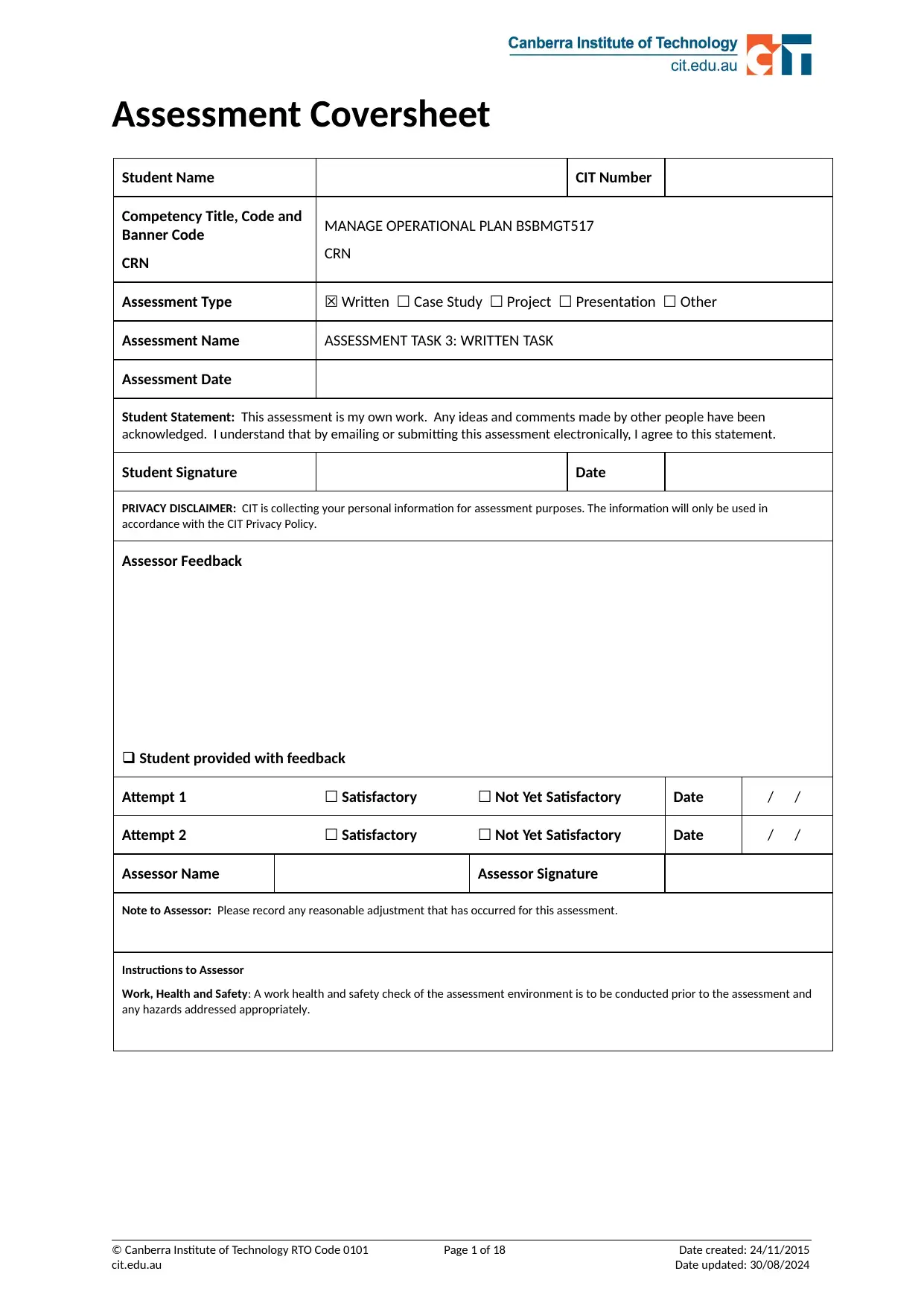
Assessment Coversheet
Student Name CIT Number
Competency Title, Code and
Banner Code
CRN
MANAGE OPERATIONAL PLAN BSBMGT517
CRN
Assessment Type ☒ Written ☐ Case Study ☐ Project ☐ Presentation ☐ Other
Assessment Name ASSESSMENT TASK 3: WRITTEN TASK
Assessment Date
Student Statement: This assessment is my own work. Any ideas and comments made by other people have been
acknowledged. I understand that by emailing or submitting this assessment electronically, I agree to this statement.
Student Signature Date
PRIVACY DISCLAIMER: CIT is collecting your personal information for assessment purposes. The information will only be used in
accordance with the CIT Privacy Policy.
Assessor Feedback
Student provided with feedback
Attempt 1 ☐ Satisfactory ☐ Not Yet Satisfactory Date / /
Attempt 2 ☐ Satisfactory ☐ Not Yet Satisfactory Date / /
Assessor Name Assessor Signature
Note to Assessor: Please record any reasonable adjustment that has occurred for this assessment.
Instructions to Assessor
Work, Health and Safety: A work health and safety check of the assessment environment is to be conducted prior to the assessment and
any hazards addressed appropriately.
© Canberra Institute of Technology RTO Code 0101 Page 1 of 18 Date created: 24/11/2015
cit.edu.au Date updated: 30/08/2024
Student Name CIT Number
Competency Title, Code and
Banner Code
CRN
MANAGE OPERATIONAL PLAN BSBMGT517
CRN
Assessment Type ☒ Written ☐ Case Study ☐ Project ☐ Presentation ☐ Other
Assessment Name ASSESSMENT TASK 3: WRITTEN TASK
Assessment Date
Student Statement: This assessment is my own work. Any ideas and comments made by other people have been
acknowledged. I understand that by emailing or submitting this assessment electronically, I agree to this statement.
Student Signature Date
PRIVACY DISCLAIMER: CIT is collecting your personal information for assessment purposes. The information will only be used in
accordance with the CIT Privacy Policy.
Assessor Feedback
Student provided with feedback
Attempt 1 ☐ Satisfactory ☐ Not Yet Satisfactory Date / /
Attempt 2 ☐ Satisfactory ☐ Not Yet Satisfactory Date / /
Assessor Name Assessor Signature
Note to Assessor: Please record any reasonable adjustment that has occurred for this assessment.
Instructions to Assessor
Work, Health and Safety: A work health and safety check of the assessment environment is to be conducted prior to the assessment and
any hazards addressed appropriately.
© Canberra Institute of Technology RTO Code 0101 Page 1 of 18 Date created: 24/11/2015
cit.edu.au Date updated: 30/08/2024
Paraphrase This Document
Need a fresh take? Get an instant paraphrase of this document with our AI Paraphraser
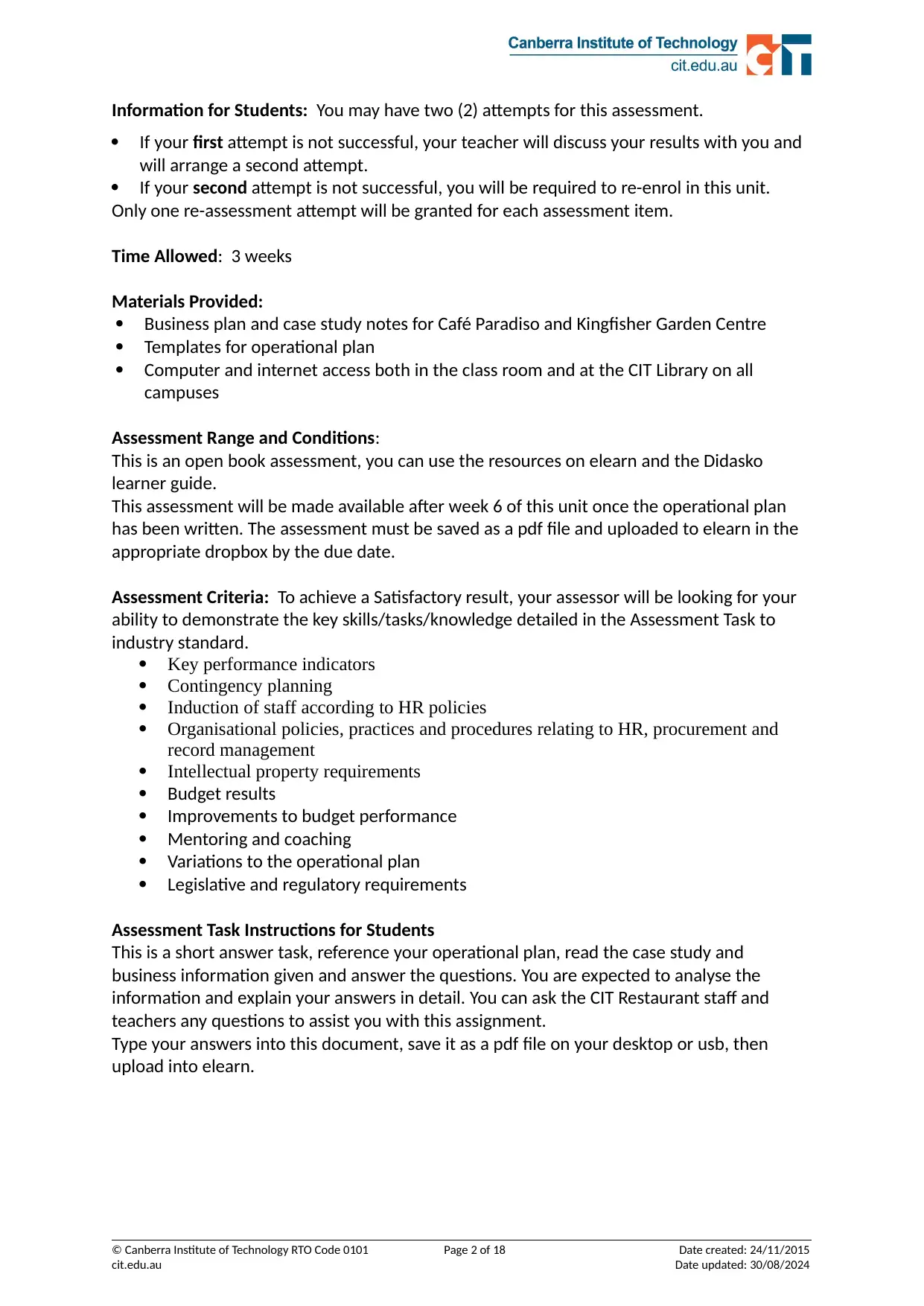
Information for Students: You may have two (2) attempts for this assessment.
If your first attempt is not successful, your teacher will discuss your results with you and
will arrange a second attempt.
If your second attempt is not successful, you will be required to re-enrol in this unit.
Only one re-assessment attempt will be granted for each assessment item.
Time Allowed: 3 weeks
Materials Provided:
Business plan and case study notes for Café Paradiso and Kingfisher Garden Centre
Templates for operational plan
Computer and internet access both in the class room and at the CIT Library on all
campuses
Assessment Range and Conditions:
This is an open book assessment, you can use the resources on elearn and the Didasko
learner guide.
This assessment will be made available after week 6 of this unit once the operational plan
has been written. The assessment must be saved as a pdf file and uploaded to elearn in the
appropriate dropbox by the due date.
Assessment Criteria: To achieve a Satisfactory result, your assessor will be looking for your
ability to demonstrate the key skills/tasks/knowledge detailed in the Assessment Task to
industry standard.
Key performance indicators
Contingency planning
Induction of staff according to HR policies
Organisational policies, practices and procedures relating to HR, procurement and
record management
Intellectual property requirements
Budget results
Improvements to budget performance
Mentoring and coaching
Variations to the operational plan
Legislative and regulatory requirements
Assessment Task Instructions for Students
This is a short answer task, reference your operational plan, read the case study and
business information given and answer the questions. You are expected to analyse the
information and explain your answers in detail. You can ask the CIT Restaurant staff and
teachers any questions to assist you with this assignment.
Type your answers into this document, save it as a pdf file on your desktop or usb, then
upload into elearn.
© Canberra Institute of Technology RTO Code 0101 Page 2 of 18 Date created: 24/11/2015
cit.edu.au Date updated: 30/08/2024
If your first attempt is not successful, your teacher will discuss your results with you and
will arrange a second attempt.
If your second attempt is not successful, you will be required to re-enrol in this unit.
Only one re-assessment attempt will be granted for each assessment item.
Time Allowed: 3 weeks
Materials Provided:
Business plan and case study notes for Café Paradiso and Kingfisher Garden Centre
Templates for operational plan
Computer and internet access both in the class room and at the CIT Library on all
campuses
Assessment Range and Conditions:
This is an open book assessment, you can use the resources on elearn and the Didasko
learner guide.
This assessment will be made available after week 6 of this unit once the operational plan
has been written. The assessment must be saved as a pdf file and uploaded to elearn in the
appropriate dropbox by the due date.
Assessment Criteria: To achieve a Satisfactory result, your assessor will be looking for your
ability to demonstrate the key skills/tasks/knowledge detailed in the Assessment Task to
industry standard.
Key performance indicators
Contingency planning
Induction of staff according to HR policies
Organisational policies, practices and procedures relating to HR, procurement and
record management
Intellectual property requirements
Budget results
Improvements to budget performance
Mentoring and coaching
Variations to the operational plan
Legislative and regulatory requirements
Assessment Task Instructions for Students
This is a short answer task, reference your operational plan, read the case study and
business information given and answer the questions. You are expected to analyse the
information and explain your answers in detail. You can ask the CIT Restaurant staff and
teachers any questions to assist you with this assignment.
Type your answers into this document, save it as a pdf file on your desktop or usb, then
upload into elearn.
© Canberra Institute of Technology RTO Code 0101 Page 2 of 18 Date created: 24/11/2015
cit.edu.au Date updated: 30/08/2024
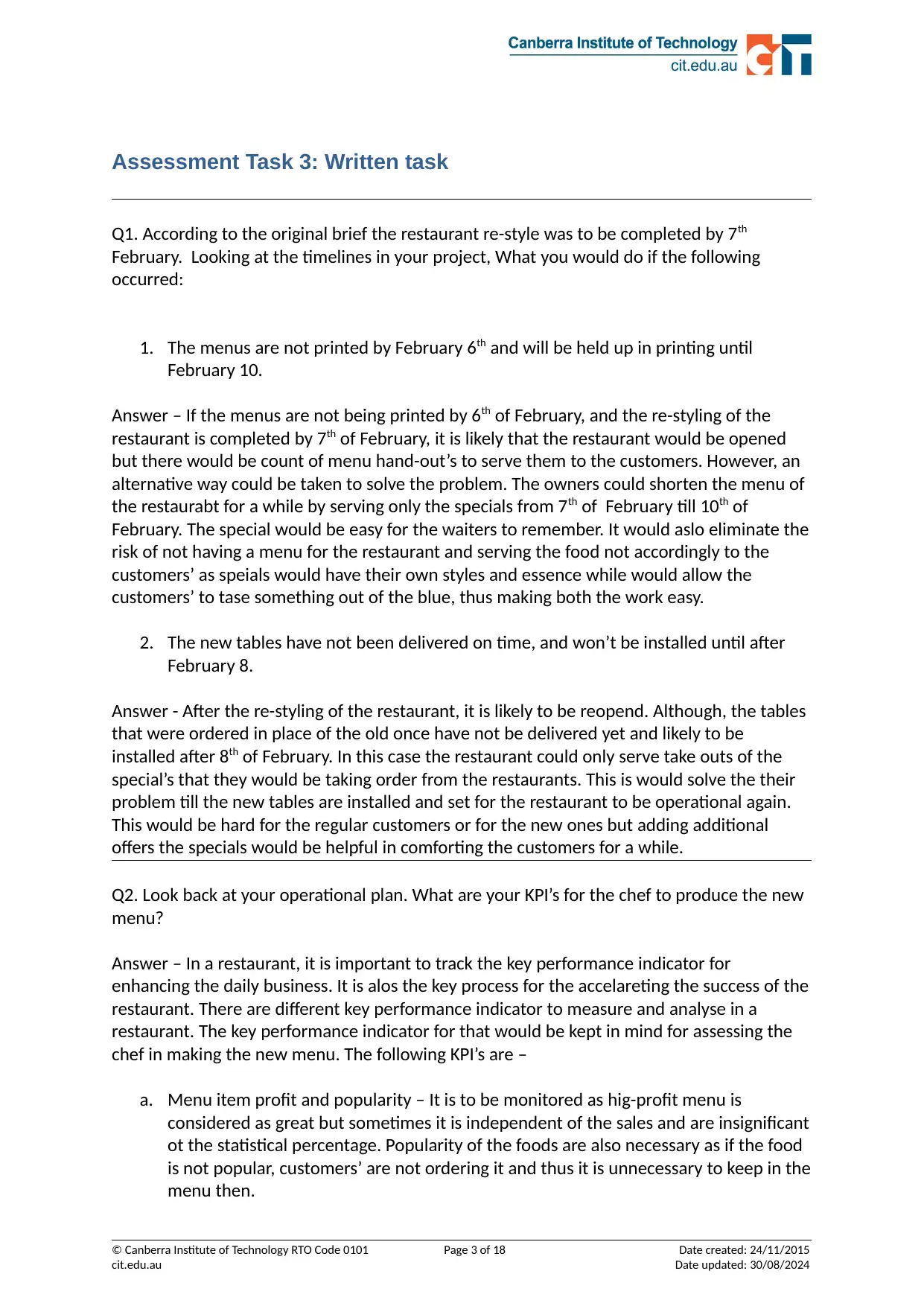
Assessment Task 3: Written task
Q1. According to the original brief the restaurant re-style was to be completed by 7th
February. Looking at the timelines in your project, What you would do if the following
occurred:
1. The menus are not printed by February 6th and will be held up in printing until
February 10.
Answer – If the menus are not being printed by 6th of February, and the re-styling of the
restaurant is completed by 7th of February, it is likely that the restaurant would be opened
but there would be count of menu hand-out’s to serve them to the customers. However, an
alternative way could be taken to solve the problem. The owners could shorten the menu of
the restaurabt for a while by serving only the specials from 7th of February till 10th of
February. The special would be easy for the waiters to remember. It would aslo eliminate the
risk of not having a menu for the restaurant and serving the food not accordingly to the
customers’ as speials would have their own styles and essence while would allow the
customers’ to tase something out of the blue, thus making both the work easy.
2. The new tables have not been delivered on time, and won’t be installed until after
February 8.
Answer - After the re-styling of the restaurant, it is likely to be reopend. Although, the tables
that were ordered in place of the old once have not be delivered yet and likely to be
installed after 8th of February. In this case the restaurant could only serve take outs of the
special’s that they would be taking order from the restaurants. This is would solve the their
problem till the new tables are installed and set for the restaurant to be operational again.
This would be hard for the regular customers or for the new ones but adding additional
offers the specials would be helpful in comforting the customers for a while.
Q2. Look back at your operational plan. What are your KPI’s for the chef to produce the new
menu?
Answer – In a restaurant, it is important to track the key performance indicator for
enhancing the daily business. It is alos the key process for the accelareting the success of the
restaurant. There are different key performance indicator to measure and analyse in a
restaurant. The key performance indicator for that would be kept in mind for assessing the
chef in making the new menu. The following KPI’s are –
a. Menu item profit and popularity – It is to be monitored as hig-profit menu is
considered as great but sometimes it is independent of the sales and are insignificant
ot the statistical percentage. Popularity of the foods are also necessary as if the food
is not popular, customers’ are not ordering it and thus it is unnecessary to keep in the
menu then.
© Canberra Institute of Technology RTO Code 0101 Page 3 of 18 Date created: 24/11/2015
cit.edu.au Date updated: 30/08/2024
Q1. According to the original brief the restaurant re-style was to be completed by 7th
February. Looking at the timelines in your project, What you would do if the following
occurred:
1. The menus are not printed by February 6th and will be held up in printing until
February 10.
Answer – If the menus are not being printed by 6th of February, and the re-styling of the
restaurant is completed by 7th of February, it is likely that the restaurant would be opened
but there would be count of menu hand-out’s to serve them to the customers. However, an
alternative way could be taken to solve the problem. The owners could shorten the menu of
the restaurabt for a while by serving only the specials from 7th of February till 10th of
February. The special would be easy for the waiters to remember. It would aslo eliminate the
risk of not having a menu for the restaurant and serving the food not accordingly to the
customers’ as speials would have their own styles and essence while would allow the
customers’ to tase something out of the blue, thus making both the work easy.
2. The new tables have not been delivered on time, and won’t be installed until after
February 8.
Answer - After the re-styling of the restaurant, it is likely to be reopend. Although, the tables
that were ordered in place of the old once have not be delivered yet and likely to be
installed after 8th of February. In this case the restaurant could only serve take outs of the
special’s that they would be taking order from the restaurants. This is would solve the their
problem till the new tables are installed and set for the restaurant to be operational again.
This would be hard for the regular customers or for the new ones but adding additional
offers the specials would be helpful in comforting the customers for a while.
Q2. Look back at your operational plan. What are your KPI’s for the chef to produce the new
menu?
Answer – In a restaurant, it is important to track the key performance indicator for
enhancing the daily business. It is alos the key process for the accelareting the success of the
restaurant. There are different key performance indicator to measure and analyse in a
restaurant. The key performance indicator for that would be kept in mind for assessing the
chef in making the new menu. The following KPI’s are –
a. Menu item profit and popularity – It is to be monitored as hig-profit menu is
considered as great but sometimes it is independent of the sales and are insignificant
ot the statistical percentage. Popularity of the foods are also necessary as if the food
is not popular, customers’ are not ordering it and thus it is unnecessary to keep in the
menu then.
© Canberra Institute of Technology RTO Code 0101 Page 3 of 18 Date created: 24/11/2015
cit.edu.au Date updated: 30/08/2024
⊘ This is a preview!⊘
Do you want full access?
Subscribe today to unlock all pages.

Trusted by 1+ million students worldwide
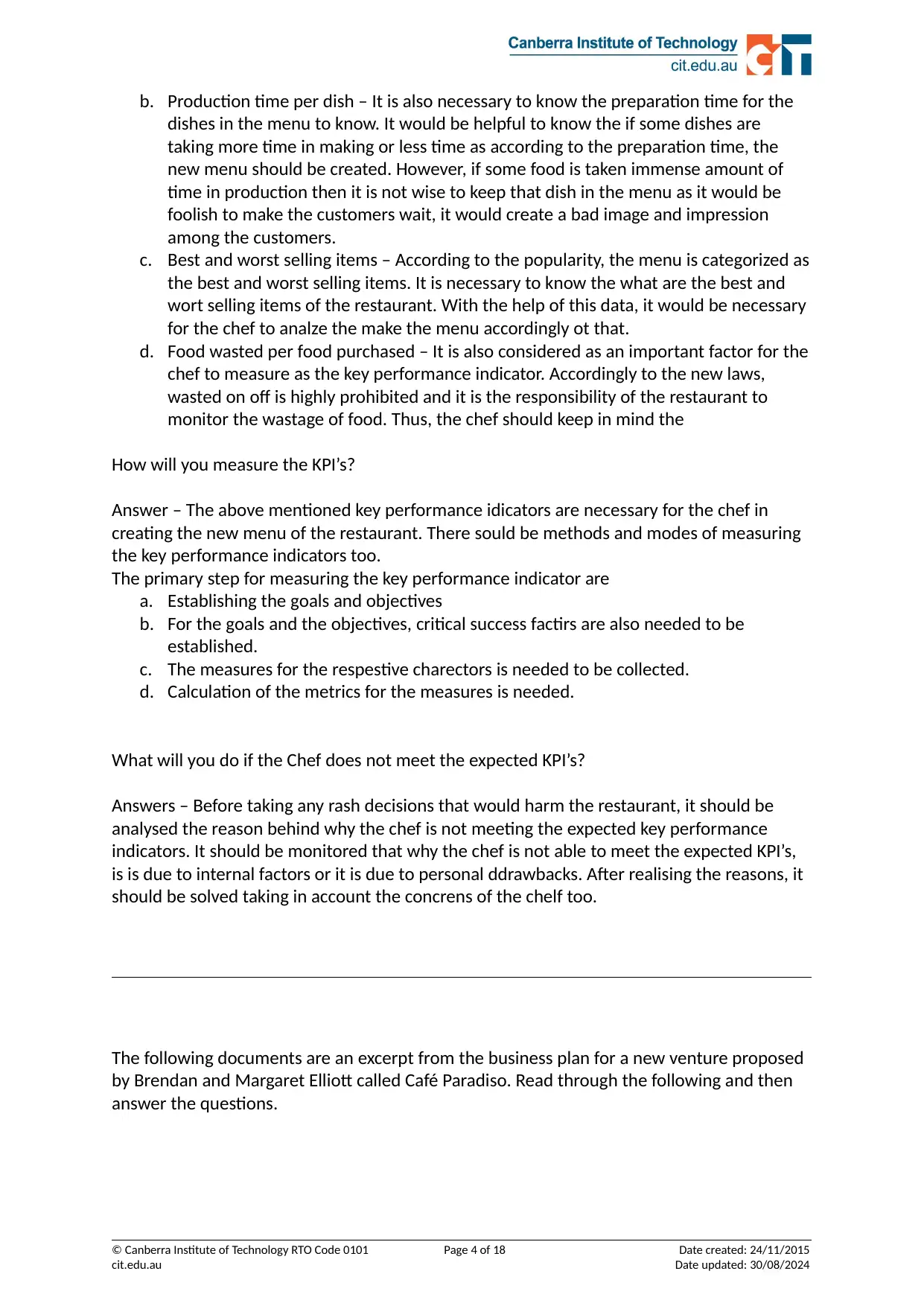
b. Production time per dish – It is also necessary to know the preparation time for the
dishes in the menu to know. It would be helpful to know the if some dishes are
taking more time in making or less time as according to the preparation time, the
new menu should be created. However, if some food is taken immense amount of
time in production then it is not wise to keep that dish in the menu as it would be
foolish to make the customers wait, it would create a bad image and impression
among the customers.
c. Best and worst selling items – According to the popularity, the menu is categorized as
the best and worst selling items. It is necessary to know the what are the best and
wort selling items of the restaurant. With the help of this data, it would be necessary
for the chef to analze the make the menu accordingly ot that.
d. Food wasted per food purchased – It is also considered as an important factor for the
chef to measure as the key performance indicator. Accordingly to the new laws,
wasted on off is highly prohibited and it is the responsibility of the restaurant to
monitor the wastage of food. Thus, the chef should keep in mind the
How will you measure the KPI’s?
Answer – The above mentioned key performance idicators are necessary for the chef in
creating the new menu of the restaurant. There sould be methods and modes of measuring
the key performance indicators too.
The primary step for measuring the key performance indicator are
a. Establishing the goals and objectives
b. For the goals and the objectives, critical success factirs are also needed to be
established.
c. The measures for the respestive charectors is needed to be collected.
d. Calculation of the metrics for the measures is needed.
What will you do if the Chef does not meet the expected KPI’s?
Answers – Before taking any rash decisions that would harm the restaurant, it should be
analysed the reason behind why the chef is not meeting the expected key performance
indicators. It should be monitored that why the chef is not able to meet the expected KPI’s,
is is due to internal factors or it is due to personal ddrawbacks. After realising the reasons, it
should be solved taking in account the concrens of the chelf too.
The following documents are an excerpt from the business plan for a new venture proposed
by Brendan and Margaret Elliott called Café Paradiso. Read through the following and then
answer the questions.
© Canberra Institute of Technology RTO Code 0101 Page 4 of 18 Date created: 24/11/2015
cit.edu.au Date updated: 30/08/2024
dishes in the menu to know. It would be helpful to know the if some dishes are
taking more time in making or less time as according to the preparation time, the
new menu should be created. However, if some food is taken immense amount of
time in production then it is not wise to keep that dish in the menu as it would be
foolish to make the customers wait, it would create a bad image and impression
among the customers.
c. Best and worst selling items – According to the popularity, the menu is categorized as
the best and worst selling items. It is necessary to know the what are the best and
wort selling items of the restaurant. With the help of this data, it would be necessary
for the chef to analze the make the menu accordingly ot that.
d. Food wasted per food purchased – It is also considered as an important factor for the
chef to measure as the key performance indicator. Accordingly to the new laws,
wasted on off is highly prohibited and it is the responsibility of the restaurant to
monitor the wastage of food. Thus, the chef should keep in mind the
How will you measure the KPI’s?
Answer – The above mentioned key performance idicators are necessary for the chef in
creating the new menu of the restaurant. There sould be methods and modes of measuring
the key performance indicators too.
The primary step for measuring the key performance indicator are
a. Establishing the goals and objectives
b. For the goals and the objectives, critical success factirs are also needed to be
established.
c. The measures for the respestive charectors is needed to be collected.
d. Calculation of the metrics for the measures is needed.
What will you do if the Chef does not meet the expected KPI’s?
Answers – Before taking any rash decisions that would harm the restaurant, it should be
analysed the reason behind why the chef is not meeting the expected key performance
indicators. It should be monitored that why the chef is not able to meet the expected KPI’s,
is is due to internal factors or it is due to personal ddrawbacks. After realising the reasons, it
should be solved taking in account the concrens of the chelf too.
The following documents are an excerpt from the business plan for a new venture proposed
by Brendan and Margaret Elliott called Café Paradiso. Read through the following and then
answer the questions.
© Canberra Institute of Technology RTO Code 0101 Page 4 of 18 Date created: 24/11/2015
cit.edu.au Date updated: 30/08/2024
Paraphrase This Document
Need a fresh take? Get an instant paraphrase of this document with our AI Paraphraser
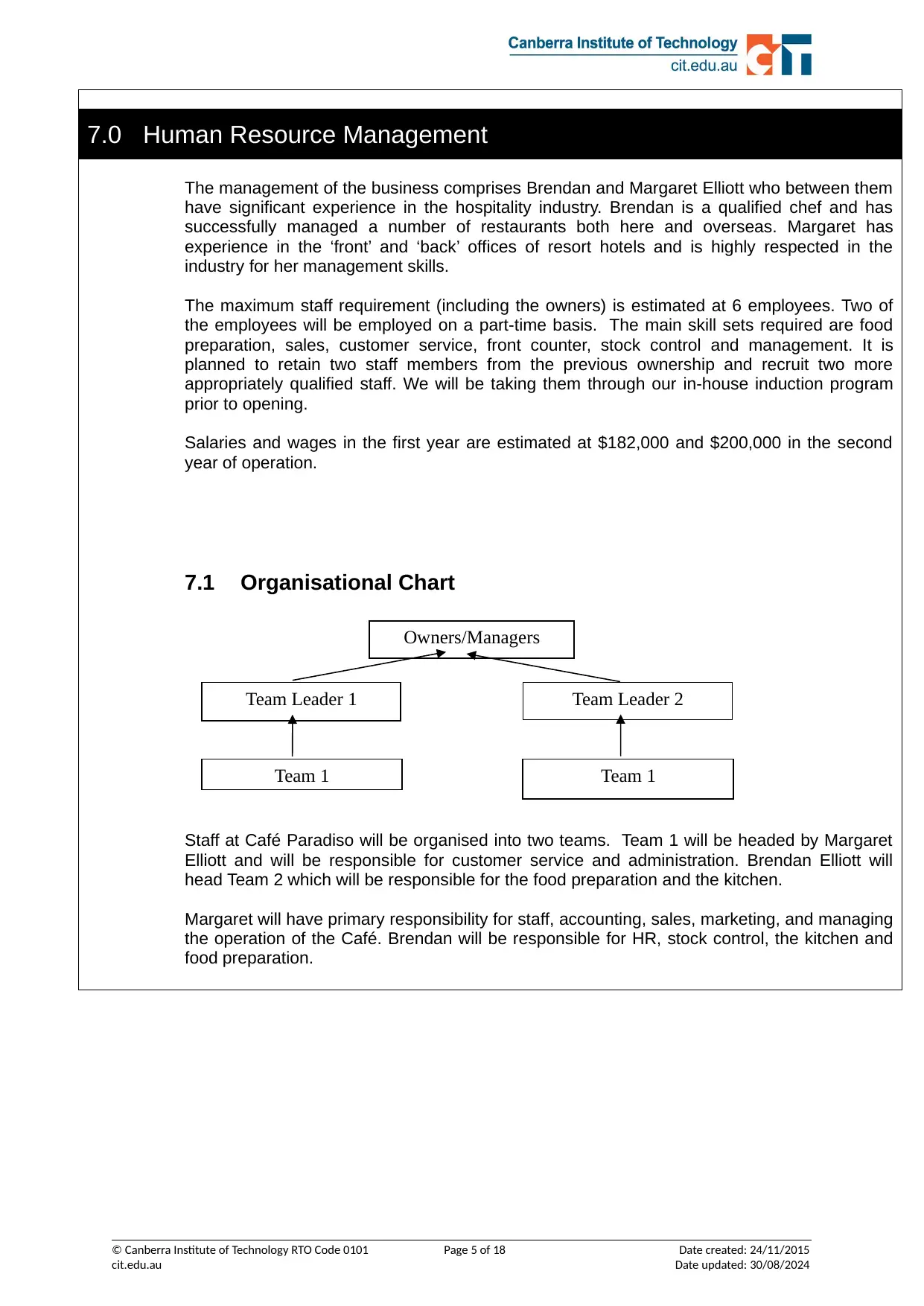
7.0 Human Resource Management
The management of the business comprises Brendan and Margaret Elliott who between them
have significant experience in the hospitality industry. Brendan is a qualified chef and has
successfully managed a number of restaurants both here and overseas. Margaret has
experience in the ‘front’ and ‘back’ offices of resort hotels and is highly respected in the
industry for her management skills.
The maximum staff requirement (including the owners) is estimated at 6 employees. Two of
the employees will be employed on a part-time basis. The main skill sets required are food
preparation, sales, customer service, front counter, stock control and management. It is
planned to retain two staff members from the previous ownership and recruit two more
appropriately qualified staff. We will be taking them through our in-house induction program
prior to opening.
Salaries and wages in the first year are estimated at $182,000 and $200,000 in the second
year of operation.
7.1 Organisational Chart
Staff at Café Paradiso will be organised into two teams. Team 1 will be headed by Margaret
Elliott and will be responsible for customer service and administration. Brendan Elliott will
head Team 2 which will be responsible for the food preparation and the kitchen.
Margaret will have primary responsibility for staff, accounting, sales, marketing, and managing
the operation of the Café. Brendan will be responsible for HR, stock control, the kitchen and
food preparation.
© Canberra Institute of Technology RTO Code 0101 Page 5 of 18 Date created: 24/11/2015
cit.edu.au Date updated: 30/08/2024
Owners/Managers
Team Leader 1 Team Leader 2
Team 1Team 1
The management of the business comprises Brendan and Margaret Elliott who between them
have significant experience in the hospitality industry. Brendan is a qualified chef and has
successfully managed a number of restaurants both here and overseas. Margaret has
experience in the ‘front’ and ‘back’ offices of resort hotels and is highly respected in the
industry for her management skills.
The maximum staff requirement (including the owners) is estimated at 6 employees. Two of
the employees will be employed on a part-time basis. The main skill sets required are food
preparation, sales, customer service, front counter, stock control and management. It is
planned to retain two staff members from the previous ownership and recruit two more
appropriately qualified staff. We will be taking them through our in-house induction program
prior to opening.
Salaries and wages in the first year are estimated at $182,000 and $200,000 in the second
year of operation.
7.1 Organisational Chart
Staff at Café Paradiso will be organised into two teams. Team 1 will be headed by Margaret
Elliott and will be responsible for customer service and administration. Brendan Elliott will
head Team 2 which will be responsible for the food preparation and the kitchen.
Margaret will have primary responsibility for staff, accounting, sales, marketing, and managing
the operation of the Café. Brendan will be responsible for HR, stock control, the kitchen and
food preparation.
© Canberra Institute of Technology RTO Code 0101 Page 5 of 18 Date created: 24/11/2015
cit.edu.au Date updated: 30/08/2024
Owners/Managers
Team Leader 1 Team Leader 2
Team 1Team 1
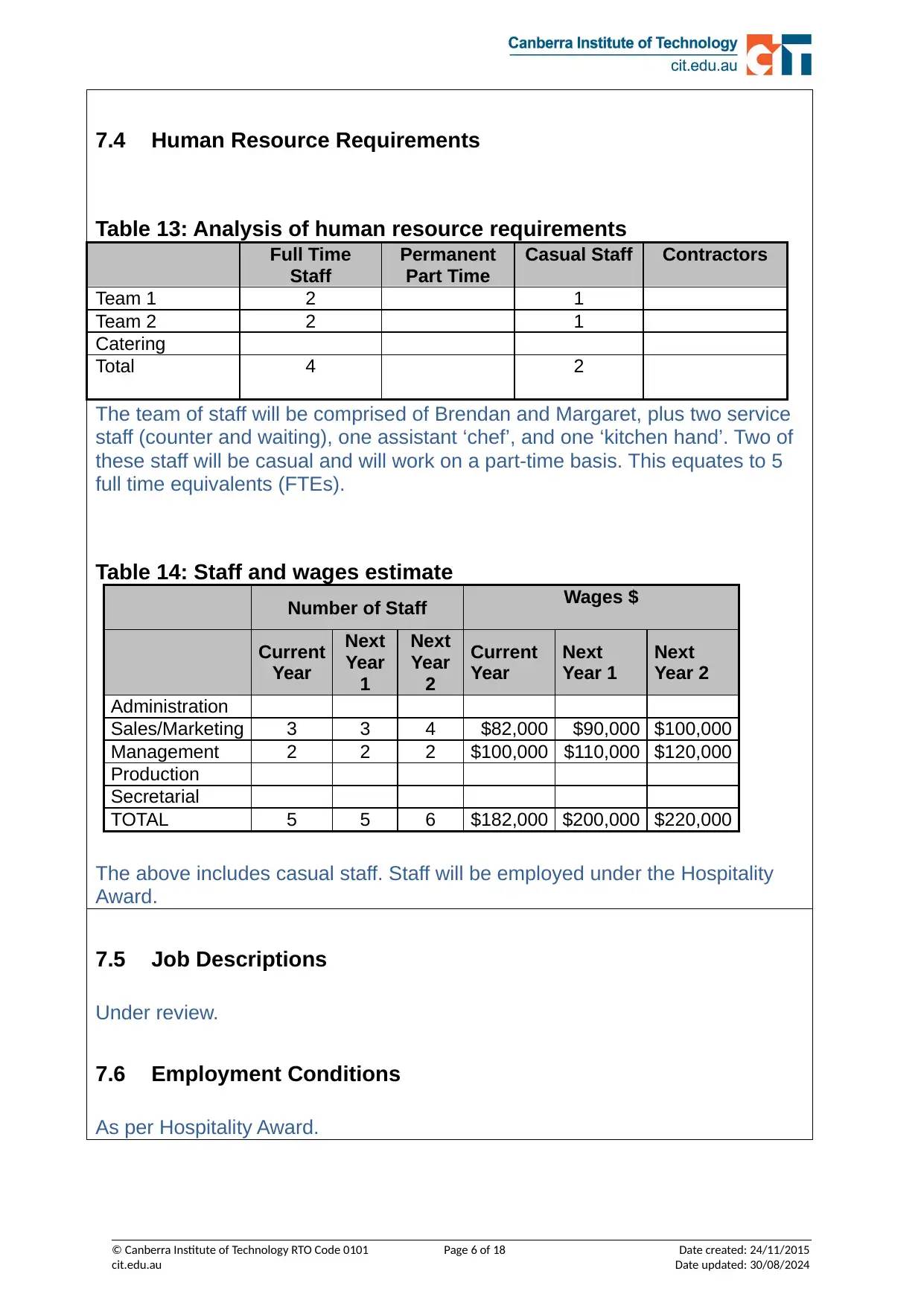
7.4 Human Resource Requirements
Table 13: Analysis of human resource requirements
The team of staff will be comprised of Brendan and Margaret, plus two service
staff (counter and waiting), one assistant ‘chef’, and one ‘kitchen hand’. Two of
these staff will be casual and will work on a part-time basis. This equates to 5
full time equivalents (FTEs).
Table 14: Staff and wages estimate
Number of Staff Wages $
Current
Year
Next
Year
1
Next
Year
2
Current
Year
Next
Year 1
Next
Year 2
Administration
Sales/Marketing 3 3 4 $82,000 $90,000 $100,000
Management 2 2 2 $100,000 $110,000 $120,000
Production
Secretarial
TOTAL 5 5 6 $182,000 $200,000 $220,000
The above includes casual staff. Staff will be employed under the Hospitality
Award.
7.5 Job Descriptions
Under review.
7.6 Employment Conditions
As per Hospitality Award.
© Canberra Institute of Technology RTO Code 0101 Page 6 of 18 Date created: 24/11/2015
cit.edu.au Date updated: 30/08/2024
Full Time
Staff
Permanent
Part Time
Casual Staff Contractors
Team 1 2 1
Team 2 2 1
Catering
Total 4 2
Table 13: Analysis of human resource requirements
The team of staff will be comprised of Brendan and Margaret, plus two service
staff (counter and waiting), one assistant ‘chef’, and one ‘kitchen hand’. Two of
these staff will be casual and will work on a part-time basis. This equates to 5
full time equivalents (FTEs).
Table 14: Staff and wages estimate
Number of Staff Wages $
Current
Year
Next
Year
1
Next
Year
2
Current
Year
Next
Year 1
Next
Year 2
Administration
Sales/Marketing 3 3 4 $82,000 $90,000 $100,000
Management 2 2 2 $100,000 $110,000 $120,000
Production
Secretarial
TOTAL 5 5 6 $182,000 $200,000 $220,000
The above includes casual staff. Staff will be employed under the Hospitality
Award.
7.5 Job Descriptions
Under review.
7.6 Employment Conditions
As per Hospitality Award.
© Canberra Institute of Technology RTO Code 0101 Page 6 of 18 Date created: 24/11/2015
cit.edu.au Date updated: 30/08/2024
Full Time
Staff
Permanent
Part Time
Casual Staff Contractors
Team 1 2 1
Team 2 2 1
Catering
Total 4 2
⊘ This is a preview!⊘
Do you want full access?
Subscribe today to unlock all pages.

Trusted by 1+ million students worldwide
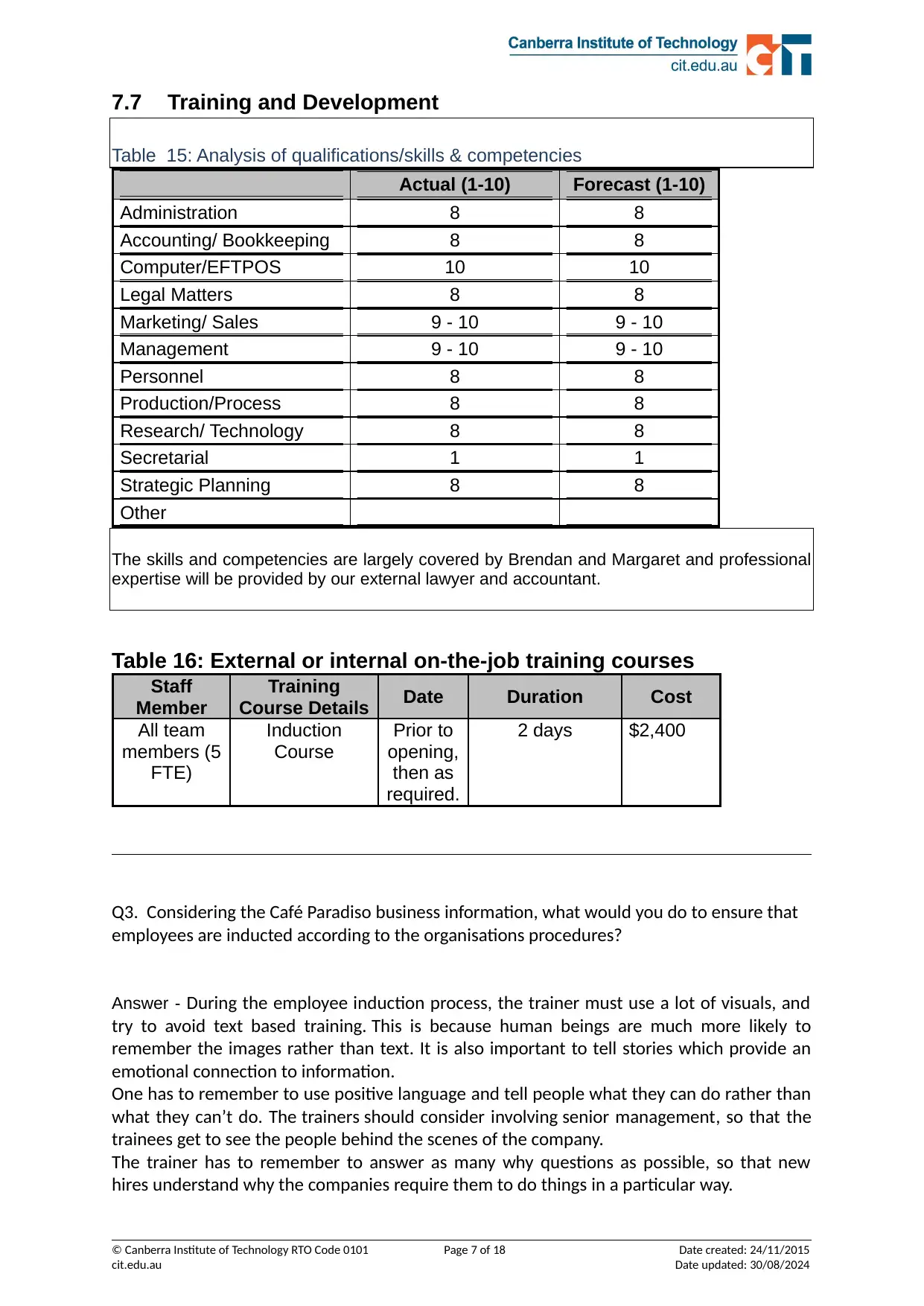
7.7 Training and Development
Table 15: Analysis of qualifications/skills & competencies
Actual (1-10) Forecast (1-10)
Administration 8 8
Accounting/ Bookkeeping 8 8
Computer/EFTPOS 10 10
Legal Matters 8 8
Marketing/ Sales 9 - 10 9 - 10
Management 9 - 10 9 - 10
Personnel 8 8
Production/Process 8 8
Research/ Technology 8 8
Secretarial 1 1
Strategic Planning 8 8
Other
The skills and competencies are largely covered by Brendan and Margaret and professional
expertise will be provided by our external lawyer and accountant.
Table 16: External or internal on-the-job training courses
Staff
Member
Training
Course Details Date Duration Cost
All team
members (5
FTE)
Induction
Course
Prior to
opening,
then as
required.
2 days $2,400
Q3. Considering the Café Paradiso business information, what would you do to ensure that
employees are inducted according to the organisations procedures?
Answer - During the employee induction process, the trainer must use a lot of visuals, and
try to avoid text based training. This is because human beings are much more likely to
remember the images rather than text. It is also important to tell stories which provide an
emotional connection to information.
One has to remember to use positive language and tell people what they can do rather than
what they can’t do. The trainers should consider involving senior management, so that the
trainees get to see the people behind the scenes of the company.
The trainer has to remember to answer as many why questions as possible, so that new
hires understand why the companies require them to do things in a particular way.
© Canberra Institute of Technology RTO Code 0101 Page 7 of 18 Date created: 24/11/2015
cit.edu.au Date updated: 30/08/2024
Table 15: Analysis of qualifications/skills & competencies
Actual (1-10) Forecast (1-10)
Administration 8 8
Accounting/ Bookkeeping 8 8
Computer/EFTPOS 10 10
Legal Matters 8 8
Marketing/ Sales 9 - 10 9 - 10
Management 9 - 10 9 - 10
Personnel 8 8
Production/Process 8 8
Research/ Technology 8 8
Secretarial 1 1
Strategic Planning 8 8
Other
The skills and competencies are largely covered by Brendan and Margaret and professional
expertise will be provided by our external lawyer and accountant.
Table 16: External or internal on-the-job training courses
Staff
Member
Training
Course Details Date Duration Cost
All team
members (5
FTE)
Induction
Course
Prior to
opening,
then as
required.
2 days $2,400
Q3. Considering the Café Paradiso business information, what would you do to ensure that
employees are inducted according to the organisations procedures?
Answer - During the employee induction process, the trainer must use a lot of visuals, and
try to avoid text based training. This is because human beings are much more likely to
remember the images rather than text. It is also important to tell stories which provide an
emotional connection to information.
One has to remember to use positive language and tell people what they can do rather than
what they can’t do. The trainers should consider involving senior management, so that the
trainees get to see the people behind the scenes of the company.
The trainer has to remember to answer as many why questions as possible, so that new
hires understand why the companies require them to do things in a particular way.
© Canberra Institute of Technology RTO Code 0101 Page 7 of 18 Date created: 24/11/2015
cit.edu.au Date updated: 30/08/2024
Paraphrase This Document
Need a fresh take? Get an instant paraphrase of this document with our AI Paraphraser
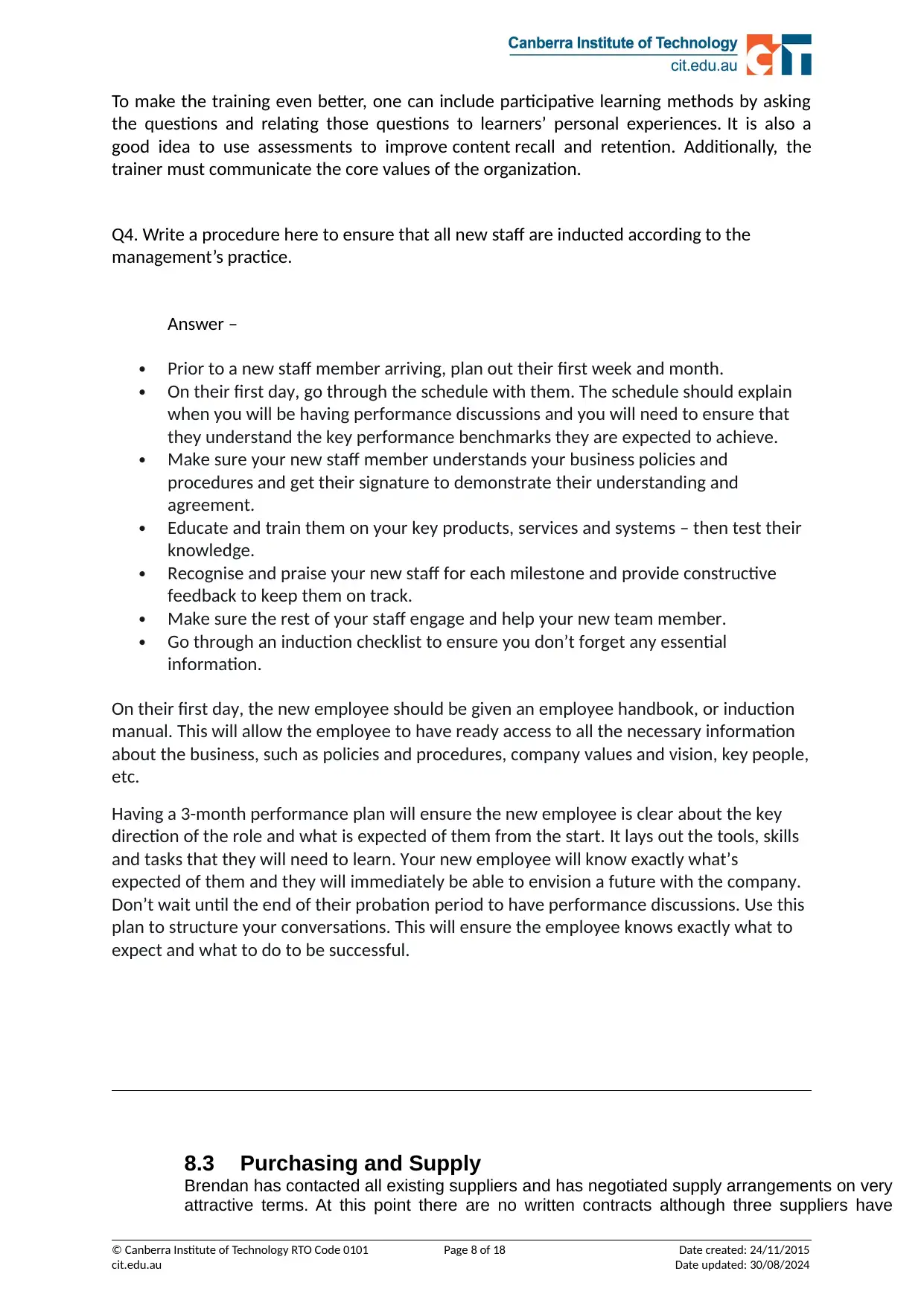
To make the training even better, one can include participative learning methods by asking
the questions and relating those questions to learners’ personal experiences. It is also a
good idea to use assessments to improve content recall and retention. Additionally, the
trainer must communicate the core values of the organization.
Q4. Write a procedure here to ensure that all new staff are inducted according to the
management’s practice.
Answer –
Prior to a new staff member arriving, plan out their first week and month.
On their first day, go through the schedule with them. The schedule should explain
when you will be having performance discussions and you will need to ensure that
they understand the key performance benchmarks they are expected to achieve.
Make sure your new staff member understands your business policies and
procedures and get their signature to demonstrate their understanding and
agreement.
Educate and train them on your key products, services and systems – then test their
knowledge.
Recognise and praise your new staff for each milestone and provide constructive
feedback to keep them on track.
Make sure the rest of your staff engage and help your new team member.
Go through an induction checklist to ensure you don’t forget any essential
information.
On their first day, the new employee should be given an employee handbook, or induction
manual. This will allow the employee to have ready access to all the necessary information
about the business, such as policies and procedures, company values and vision, key people,
etc.
Having a 3-month performance plan will ensure the new employee is clear about the key
direction of the role and what is expected of them from the start. It lays out the tools, skills
and tasks that they will need to learn. Your new employee will know exactly what’s
expected of them and they will immediately be able to envision a future with the company.
Don’t wait until the end of their probation period to have performance discussions. Use this
plan to structure your conversations. This will ensure the employee knows exactly what to
expect and what to do to be successful.
8.3 Purchasing and Supply
Brendan has contacted all existing suppliers and has negotiated supply arrangements on very
attractive terms. At this point there are no written contracts although three suppliers have
© Canberra Institute of Technology RTO Code 0101 Page 8 of 18 Date created: 24/11/2015
cit.edu.au Date updated: 30/08/2024
the questions and relating those questions to learners’ personal experiences. It is also a
good idea to use assessments to improve content recall and retention. Additionally, the
trainer must communicate the core values of the organization.
Q4. Write a procedure here to ensure that all new staff are inducted according to the
management’s practice.
Answer –
Prior to a new staff member arriving, plan out their first week and month.
On their first day, go through the schedule with them. The schedule should explain
when you will be having performance discussions and you will need to ensure that
they understand the key performance benchmarks they are expected to achieve.
Make sure your new staff member understands your business policies and
procedures and get their signature to demonstrate their understanding and
agreement.
Educate and train them on your key products, services and systems – then test their
knowledge.
Recognise and praise your new staff for each milestone and provide constructive
feedback to keep them on track.
Make sure the rest of your staff engage and help your new team member.
Go through an induction checklist to ensure you don’t forget any essential
information.
On their first day, the new employee should be given an employee handbook, or induction
manual. This will allow the employee to have ready access to all the necessary information
about the business, such as policies and procedures, company values and vision, key people,
etc.
Having a 3-month performance plan will ensure the new employee is clear about the key
direction of the role and what is expected of them from the start. It lays out the tools, skills
and tasks that they will need to learn. Your new employee will know exactly what’s
expected of them and they will immediately be able to envision a future with the company.
Don’t wait until the end of their probation period to have performance discussions. Use this
plan to structure your conversations. This will ensure the employee knows exactly what to
expect and what to do to be successful.
8.3 Purchasing and Supply
Brendan has contacted all existing suppliers and has negotiated supply arrangements on very
attractive terms. At this point there are no written contracts although three suppliers have
© Canberra Institute of Technology RTO Code 0101 Page 8 of 18 Date created: 24/11/2015
cit.edu.au Date updated: 30/08/2024
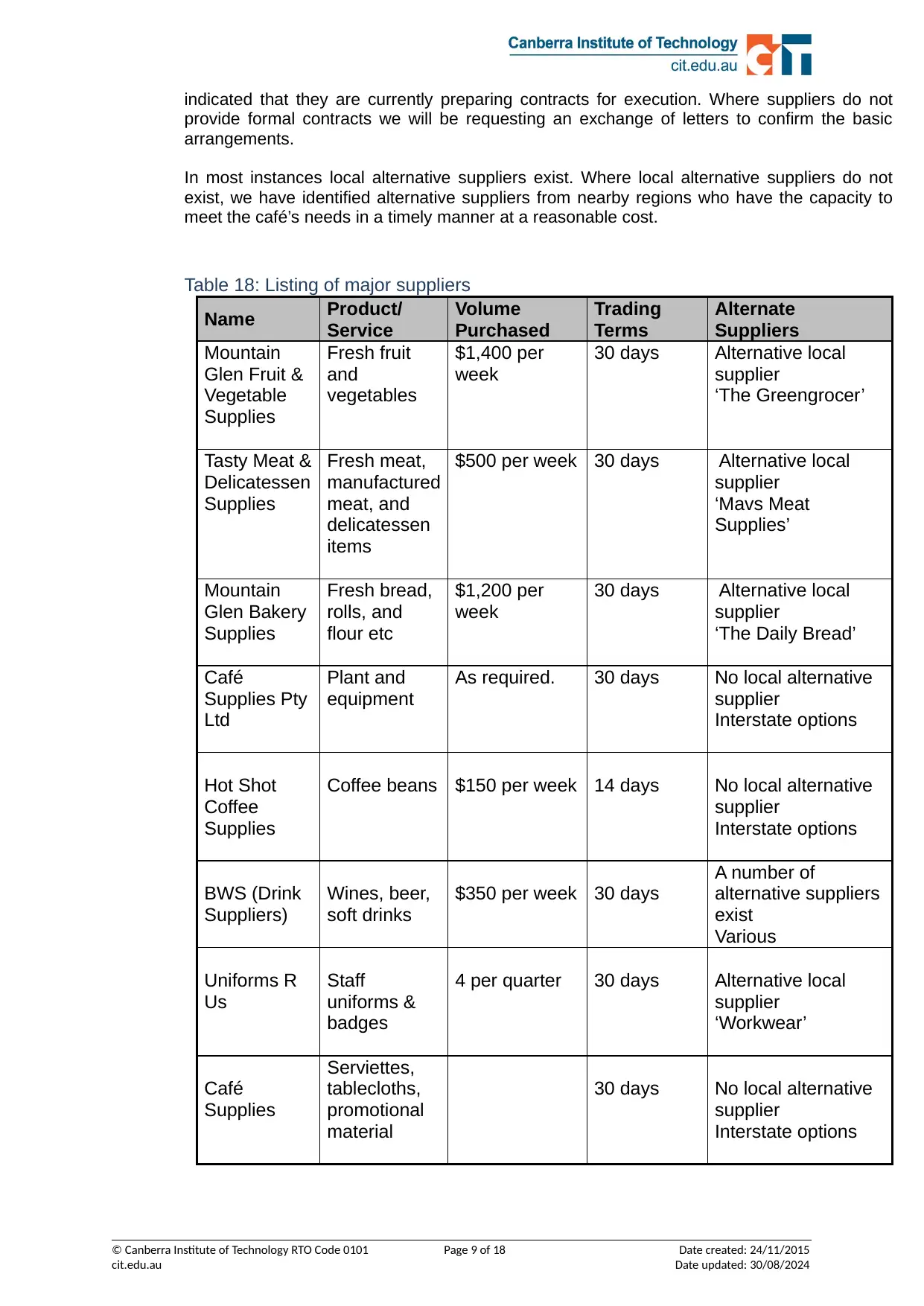
indicated that they are currently preparing contracts for execution. Where suppliers do not
provide formal contracts we will be requesting an exchange of letters to confirm the basic
arrangements.
In most instances local alternative suppliers exist. Where local alternative suppliers do not
exist, we have identified alternative suppliers from nearby regions who have the capacity to
meet the café’s needs in a timely manner at a reasonable cost.
Table 18: Listing of major suppliers
Name Product/
Service
Volume
Purchased
Trading
Terms
Alternate
Suppliers
Mountain
Glen Fruit &
Vegetable
Supplies
Fresh fruit
and
vegetables
$1,400 per
week
30 days Alternative local
supplier
‘The Greengrocer’
Tasty Meat &
Delicatessen
Supplies
Fresh meat,
manufactured
meat, and
delicatessen
items
$500 per week 30 days Alternative local
supplier
‘Mavs Meat
Supplies’
Mountain
Glen Bakery
Supplies
Fresh bread,
rolls, and
flour etc
$1,200 per
week
30 days Alternative local
supplier
‘The Daily Bread’
Café
Supplies Pty
Ltd
Plant and
equipment
As required. 30 days No local alternative
supplier
Interstate options
Hot Shot
Coffee
Supplies
Coffee beans $150 per week 14 days No local alternative
supplier
Interstate options
BWS (Drink
Suppliers)
Wines, beer,
soft drinks
$350 per week 30 days
A number of
alternative suppliers
exist
Various
Uniforms R
Us
Staff
uniforms &
badges
4 per quarter 30 days Alternative local
supplier
‘Workwear’
Café
Supplies
Serviettes,
tablecloths,
promotional
material
30 days No local alternative
supplier
Interstate options
© Canberra Institute of Technology RTO Code 0101 Page 9 of 18 Date created: 24/11/2015
cit.edu.au Date updated: 30/08/2024
provide formal contracts we will be requesting an exchange of letters to confirm the basic
arrangements.
In most instances local alternative suppliers exist. Where local alternative suppliers do not
exist, we have identified alternative suppliers from nearby regions who have the capacity to
meet the café’s needs in a timely manner at a reasonable cost.
Table 18: Listing of major suppliers
Name Product/
Service
Volume
Purchased
Trading
Terms
Alternate
Suppliers
Mountain
Glen Fruit &
Vegetable
Supplies
Fresh fruit
and
vegetables
$1,400 per
week
30 days Alternative local
supplier
‘The Greengrocer’
Tasty Meat &
Delicatessen
Supplies
Fresh meat,
manufactured
meat, and
delicatessen
items
$500 per week 30 days Alternative local
supplier
‘Mavs Meat
Supplies’
Mountain
Glen Bakery
Supplies
Fresh bread,
rolls, and
flour etc
$1,200 per
week
30 days Alternative local
supplier
‘The Daily Bread’
Café
Supplies Pty
Ltd
Plant and
equipment
As required. 30 days No local alternative
supplier
Interstate options
Hot Shot
Coffee
Supplies
Coffee beans $150 per week 14 days No local alternative
supplier
Interstate options
BWS (Drink
Suppliers)
Wines, beer,
soft drinks
$350 per week 30 days
A number of
alternative suppliers
exist
Various
Uniforms R
Us
Staff
uniforms &
badges
4 per quarter 30 days Alternative local
supplier
‘Workwear’
Café
Supplies
Serviettes,
tablecloths,
promotional
material
30 days No local alternative
supplier
Interstate options
© Canberra Institute of Technology RTO Code 0101 Page 9 of 18 Date created: 24/11/2015
cit.edu.au Date updated: 30/08/2024
⊘ This is a preview!⊘
Do you want full access?
Subscribe today to unlock all pages.

Trusted by 1+ million students worldwide
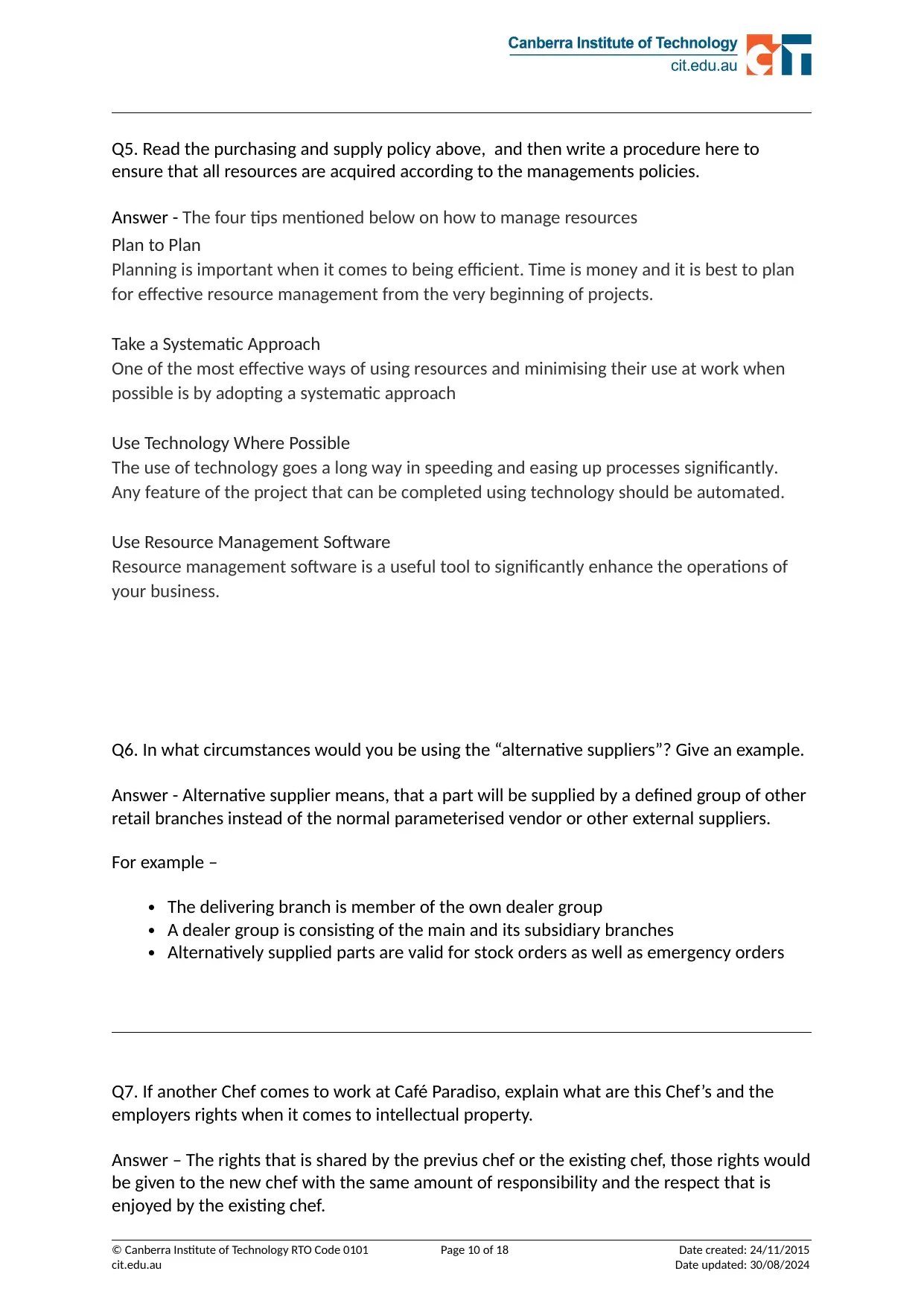
Q5. Read the purchasing and supply policy above, and then write a procedure here to
ensure that all resources are acquired according to the managements policies.
Answer - The four tips mentioned below on how to manage resources
Plan to Plan
Planning is important when it comes to being efficient. Time is money and it is best to plan
for effective resource management from the very beginning of projects.
Take a Systematic Approach
One of the most effective ways of using resources and minimising their use at work when
possible is by adopting a systematic approach
Use Technology Where Possible
The use of technology goes a long way in speeding and easing up processes significantly.
Any feature of the project that can be completed using technology should be automated.
Use Resource Management Software
Resource management software is a useful tool to significantly enhance the operations of
your business.
Q6. In what circumstances would you be using the “alternative suppliers”? Give an example.
Answer - Alternative supplier means, that a part will be supplied by a defined group of other
retail branches instead of the normal parameterised vendor or other external suppliers.
For example –
The delivering branch is member of the own dealer group
A dealer group is consisting of the main and its subsidiary branches
Alternatively supplied parts are valid for stock orders as well as emergency orders
Q7. If another Chef comes to work at Café Paradiso, explain what are this Chef’s and the
employers rights when it comes to intellectual property.
Answer – The rights that is shared by the previus chef or the existing chef, those rights would
be given to the new chef with the same amount of responsibility and the respect that is
enjoyed by the existing chef.
© Canberra Institute of Technology RTO Code 0101 Page 10 of 18 Date created: 24/11/2015
cit.edu.au Date updated: 30/08/2024
ensure that all resources are acquired according to the managements policies.
Answer - The four tips mentioned below on how to manage resources
Plan to Plan
Planning is important when it comes to being efficient. Time is money and it is best to plan
for effective resource management from the very beginning of projects.
Take a Systematic Approach
One of the most effective ways of using resources and minimising their use at work when
possible is by adopting a systematic approach
Use Technology Where Possible
The use of technology goes a long way in speeding and easing up processes significantly.
Any feature of the project that can be completed using technology should be automated.
Use Resource Management Software
Resource management software is a useful tool to significantly enhance the operations of
your business.
Q6. In what circumstances would you be using the “alternative suppliers”? Give an example.
Answer - Alternative supplier means, that a part will be supplied by a defined group of other
retail branches instead of the normal parameterised vendor or other external suppliers.
For example –
The delivering branch is member of the own dealer group
A dealer group is consisting of the main and its subsidiary branches
Alternatively supplied parts are valid for stock orders as well as emergency orders
Q7. If another Chef comes to work at Café Paradiso, explain what are this Chef’s and the
employers rights when it comes to intellectual property.
Answer – The rights that is shared by the previus chef or the existing chef, those rights would
be given to the new chef with the same amount of responsibility and the respect that is
enjoyed by the existing chef.
© Canberra Institute of Technology RTO Code 0101 Page 10 of 18 Date created: 24/11/2015
cit.edu.au Date updated: 30/08/2024
Paraphrase This Document
Need a fresh take? Get an instant paraphrase of this document with our AI Paraphraser
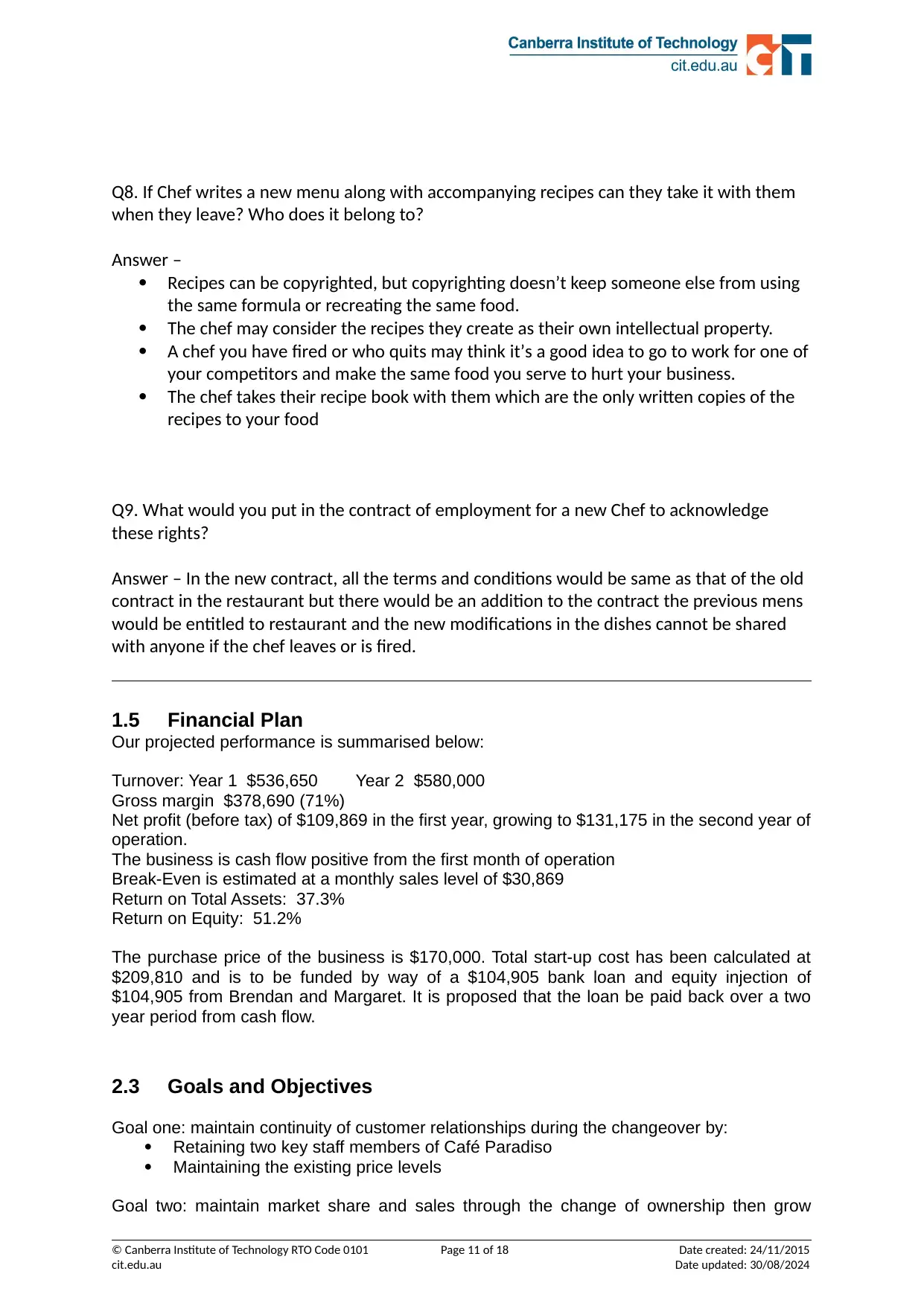
Q8. If Chef writes a new menu along with accompanying recipes can they take it with them
when they leave? Who does it belong to?
Answer –
Recipes can be copyrighted, but copyrighting doesn’t keep someone else from using
the same formula or recreating the same food.
The chef may consider the recipes they create as their own intellectual property.
A chef you have fired or who quits may think it’s a good idea to go to work for one of
your competitors and make the same food you serve to hurt your business.
The chef takes their recipe book with them which are the only written copies of the
recipes to your food
Q9. What would you put in the contract of employment for a new Chef to acknowledge
these rights?
Answer – In the new contract, all the terms and conditions would be same as that of the old
contract in the restaurant but there would be an addition to the contract the previous mens
would be entitled to restaurant and the new modifications in the dishes cannot be shared
with anyone if the chef leaves or is fired.
1.5 Financial Plan
Our projected performance is summarised below:
Turnover: Year 1 $536,650 Year 2 $580,000
Gross margin $378,690 (71%)
Net profit (before tax) of $109,869 in the first year, growing to $131,175 in the second year of
operation.
The business is cash flow positive from the first month of operation
Break-Even is estimated at a monthly sales level of $30,869
Return on Total Assets: 37.3%
Return on Equity: 51.2%
The purchase price of the business is $170,000. Total start-up cost has been calculated at
$209,810 and is to be funded by way of a $104,905 bank loan and equity injection of
$104,905 from Brendan and Margaret. It is proposed that the loan be paid back over a two
year period from cash flow.
2.3 Goals and Objectives
Goal one: maintain continuity of customer relationships during the changeover by:
Retaining two key staff members of Café Paradiso
Maintaining the existing price levels
Goal two: maintain market share and sales through the change of ownership then grow
© Canberra Institute of Technology RTO Code 0101 Page 11 of 18 Date created: 24/11/2015
cit.edu.au Date updated: 30/08/2024
when they leave? Who does it belong to?
Answer –
Recipes can be copyrighted, but copyrighting doesn’t keep someone else from using
the same formula or recreating the same food.
The chef may consider the recipes they create as their own intellectual property.
A chef you have fired or who quits may think it’s a good idea to go to work for one of
your competitors and make the same food you serve to hurt your business.
The chef takes their recipe book with them which are the only written copies of the
recipes to your food
Q9. What would you put in the contract of employment for a new Chef to acknowledge
these rights?
Answer – In the new contract, all the terms and conditions would be same as that of the old
contract in the restaurant but there would be an addition to the contract the previous mens
would be entitled to restaurant and the new modifications in the dishes cannot be shared
with anyone if the chef leaves or is fired.
1.5 Financial Plan
Our projected performance is summarised below:
Turnover: Year 1 $536,650 Year 2 $580,000
Gross margin $378,690 (71%)
Net profit (before tax) of $109,869 in the first year, growing to $131,175 in the second year of
operation.
The business is cash flow positive from the first month of operation
Break-Even is estimated at a monthly sales level of $30,869
Return on Total Assets: 37.3%
Return on Equity: 51.2%
The purchase price of the business is $170,000. Total start-up cost has been calculated at
$209,810 and is to be funded by way of a $104,905 bank loan and equity injection of
$104,905 from Brendan and Margaret. It is proposed that the loan be paid back over a two
year period from cash flow.
2.3 Goals and Objectives
Goal one: maintain continuity of customer relationships during the changeover by:
Retaining two key staff members of Café Paradiso
Maintaining the existing price levels
Goal two: maintain market share and sales through the change of ownership then grow
© Canberra Institute of Technology RTO Code 0101 Page 11 of 18 Date created: 24/11/2015
cit.edu.au Date updated: 30/08/2024
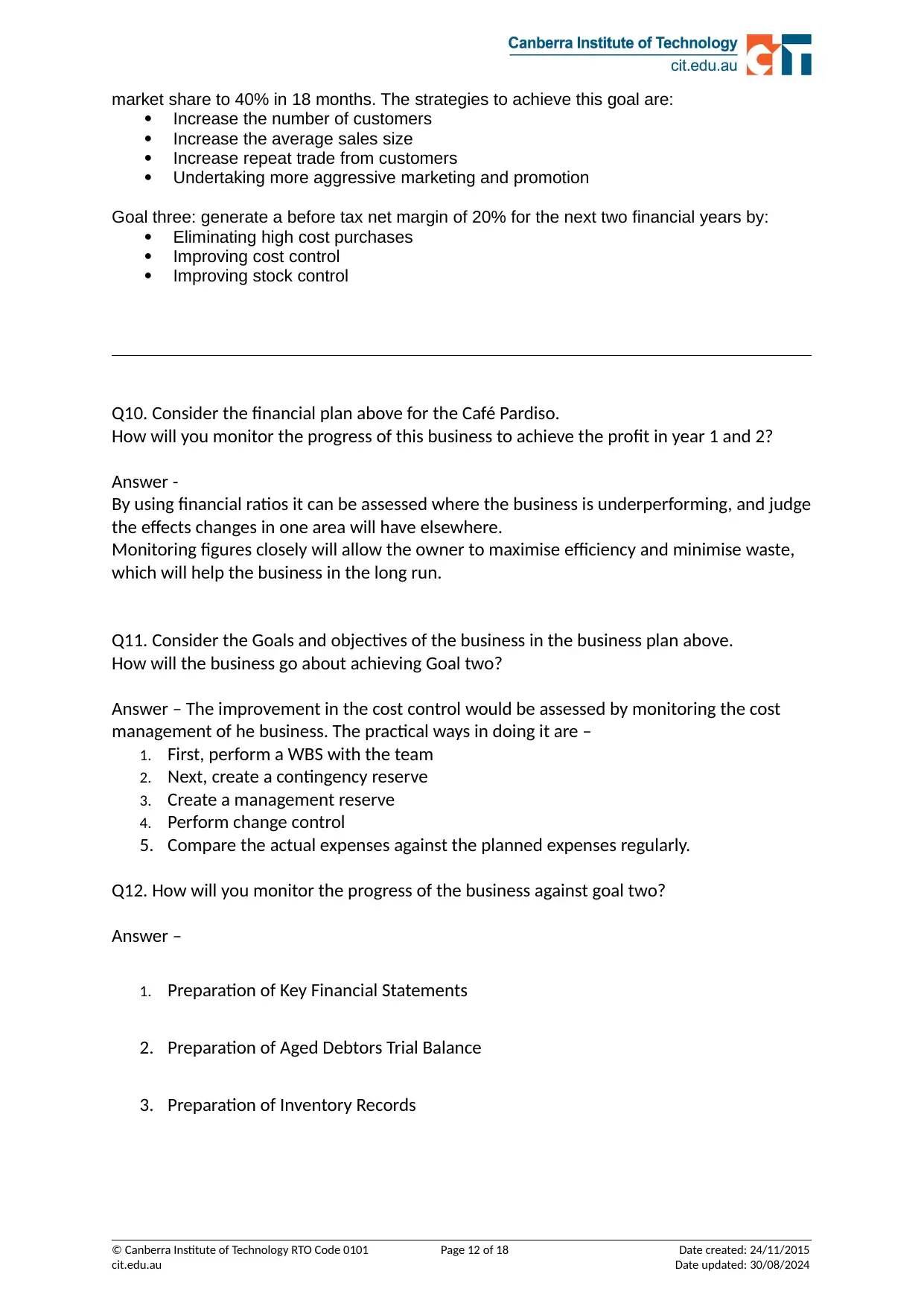
market share to 40% in 18 months. The strategies to achieve this goal are:
Increase the number of customers
Increase the average sales size
Increase repeat trade from customers
Undertaking more aggressive marketing and promotion
Goal three: generate a before tax net margin of 20% for the next two financial years by:
Eliminating high cost purchases
Improving cost control
Improving stock control
Q10. Consider the financial plan above for the Café Pardiso.
How will you monitor the progress of this business to achieve the profit in year 1 and 2?
Answer -
By using financial ratios it can be assessed where the business is underperforming, and judge
the effects changes in one area will have elsewhere.
Monitoring figures closely will allow the owner to maximise efficiency and minimise waste,
which will help the business in the long run.
Q11. Consider the Goals and objectives of the business in the business plan above.
How will the business go about achieving Goal two?
Answer – The improvement in the cost control would be assessed by monitoring the cost
management of he business. The practical ways in doing it are –
1. First, perform a WBS with the team
2. Next, create a contingency reserve
3. Create a management reserve
4. Perform change control
5. Compare the actual expenses against the planned expenses regularly.
Q12. How will you monitor the progress of the business against goal two?
Answer –
1. Preparation of Key Financial Statements
2. Preparation of Aged Debtors Trial Balance
3. Preparation of Inventory Records
© Canberra Institute of Technology RTO Code 0101 Page 12 of 18 Date created: 24/11/2015
cit.edu.au Date updated: 30/08/2024
Increase the number of customers
Increase the average sales size
Increase repeat trade from customers
Undertaking more aggressive marketing and promotion
Goal three: generate a before tax net margin of 20% for the next two financial years by:
Eliminating high cost purchases
Improving cost control
Improving stock control
Q10. Consider the financial plan above for the Café Pardiso.
How will you monitor the progress of this business to achieve the profit in year 1 and 2?
Answer -
By using financial ratios it can be assessed where the business is underperforming, and judge
the effects changes in one area will have elsewhere.
Monitoring figures closely will allow the owner to maximise efficiency and minimise waste,
which will help the business in the long run.
Q11. Consider the Goals and objectives of the business in the business plan above.
How will the business go about achieving Goal two?
Answer – The improvement in the cost control would be assessed by monitoring the cost
management of he business. The practical ways in doing it are –
1. First, perform a WBS with the team
2. Next, create a contingency reserve
3. Create a management reserve
4. Perform change control
5. Compare the actual expenses against the planned expenses regularly.
Q12. How will you monitor the progress of the business against goal two?
Answer –
1. Preparation of Key Financial Statements
2. Preparation of Aged Debtors Trial Balance
3. Preparation of Inventory Records
© Canberra Institute of Technology RTO Code 0101 Page 12 of 18 Date created: 24/11/2015
cit.edu.au Date updated: 30/08/2024
⊘ This is a preview!⊘
Do you want full access?
Subscribe today to unlock all pages.

Trusted by 1+ million students worldwide
1 out of 18
Related Documents
Your All-in-One AI-Powered Toolkit for Academic Success.
+13062052269
info@desklib.com
Available 24*7 on WhatsApp / Email
![[object Object]](/_next/static/media/star-bottom.7253800d.svg)
Unlock your academic potential
Copyright © 2020–2025 A2Z Services. All Rights Reserved. Developed and managed by ZUCOL.





